This Sesame Glazed Salmon with Green Beans is another one of those “faster than take-out” dishes. It’s incredibly simple, plus OMG it looks spectacular. Right? Look how fancy!
If you’re looking for a “date night” dish, this is probably it. It’s fast and totally uncomplicated, so you can stay focused on what your date is saying, rather than what’s happening in the pan. Grab a bottle of crisp white wine and it will be a memorable evening, for sure.
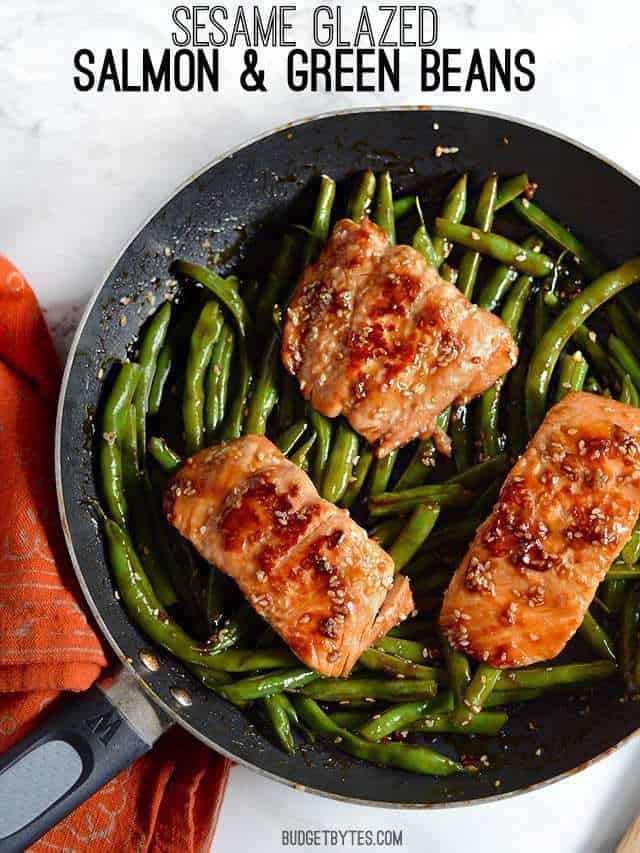
How to Serve Sesame Glazed Salmon
This recipe includes a super simple sesame marinade, which doubles as a glaze, fresh salmon filets, and green beans that are perfectly cooked until bright green and slightly tender. I served mine with jasmine rice just to round out the meal, but the glazed green beans make a pretty bed for the salmon if you want to reduce the carbs a bit.
What is Rice Wine?
Rice wine is literally wine made from rice. When wine is allowed to continue to ferment, it eventually produces vinegar. So, rice wine is a precursor to rice vinegar. It has a much more mild and sweet flavor than rice vinegar. It was my full intention to use rice vinegar in the marinade, but I discovered that I was out, so I subbed in some rice wine (not rice wine vinegar) that I had in the back of my pantry. I actually liked the rice wine much better. It made the glaze mild and sweet, instead of bold and tangy. Many popular supermarket brands, like Kikkoman and Ka-me, make rice wine, so hopefully, you can find it in major supermarkets. If you can’t find it, you can use rice vinegar, but I’d reduce the amount to 1.5 Tbsp, and just know that it will be a much tangier glaze.
Sesame Glazed Salmon and Green Beans
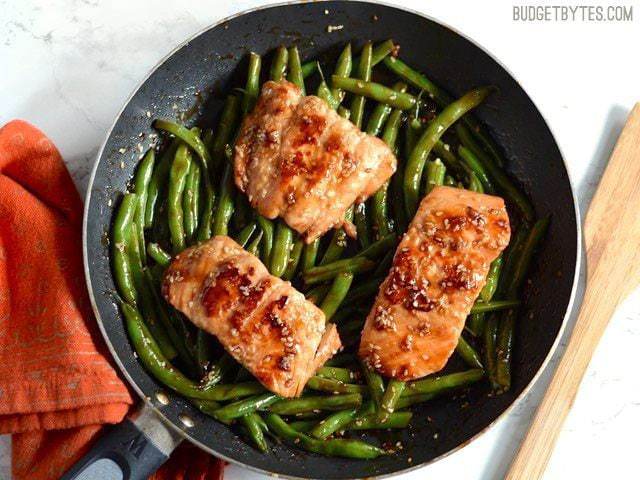
Ingredients
- 2/3 lb. salmon filet ($6.59)
- 2/3 lb. fresh green beans ($0.80)
MARINADE/GLAZE
- 3 Tbsp soy sauce ( $0.30)
- 1 Tbsp water ($0.00)
- 2 Tbsp rice wine (mirin) ($0.27)
- 2 Tbsp brown sugar ($0.04)
- 1/2 Tbsp toasted sesame oil ($0.85)
- 1 clove garlic, minced ($0.08)
- 1 inch fresh ginger, grated or minced ($0.11)
- 1 Tbsp sesame seeds ($0.15)
- 1 Tbsp cornstarch ($0.04)
Instructions
- In a small bowl, combine the soy sauce, water, rice wine, brown sugar, sesame oil, garlic, ginger, sesame seeds, and cornstarch. Stir until the cornstarch is dissolved.
- Remove the scales and/or skin from the salmon, if needed. Cut the salmon into three equal sized pieces and place them in a quart-sized zip top bag. Add about half of the marinade to the bag and let the fish marinate for about 15 minutes. Save the second half of the marinade for later.
- While the fish is marinating, snap the stems off the beans and break any long beans in half. Rinse the beans in a colander. Add the beans to a medium sauce pot, cover with water, add a lid, and bring to a boil over high heat. Allow the beans to boil until bright green and slightly tender (about 3 minutes), then drain in the colander and set aside.
- Lightly mist a non-stick skillet with non-stick spray and heat over medium-low flame. Once hot, add the salmon pieces and cook on each side until the glaze turns deep brown and the fish is cooked through (about 3-5 minutes each side). Removed the cooked salmon to a clean plate.
- Add the drained green beans to the skillet that was used to cook the salmon, along with the remaining unused marinade. Sauté the green beans in the marinade until it thickens to a shiny glaze and completely coats the green beans (about 3 minutes). Serve the fish on top of the glazed green beans.
See how we calculate recipe costs here.
Notes
Nutrition
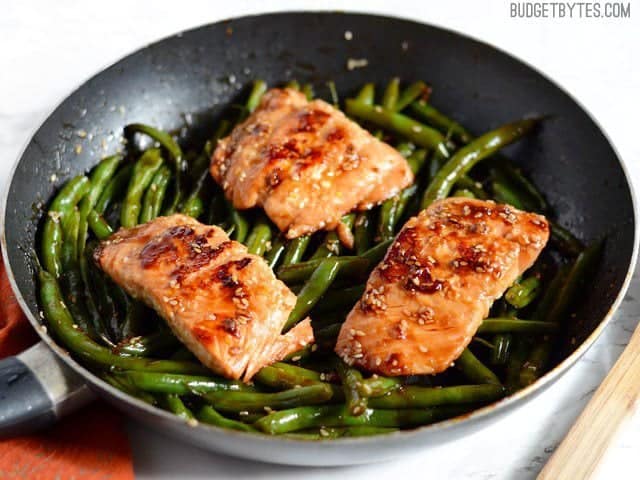
How to Make Sesame Glazed Salmon – Step by Step Photos
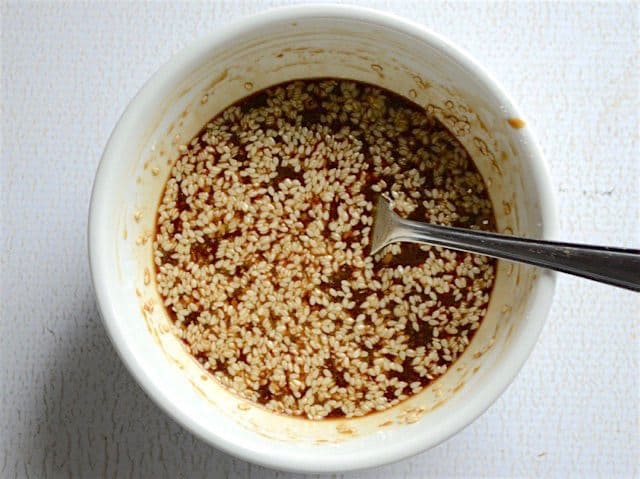
Begin by mixing together the marinade, which will also be used as a glaze. Mince a clove of garlic and grate or mince about 1 inch of fresh ginger (here’s a tutorial on how to work with fresh ginger). In a small bowl combine 3 Tbsp soy sauce, 1 Tbsp water, 2, Tbsp brown sugar, 2 Tbsp rice wine (mirin), 1/2 Tbsp toasted sesame oil, minced garlic, grated ginger, 1 Tbsp sesame seeds, and 1 Tbsp cornstarch. Stir everything together until the cornstarch has dissolved.
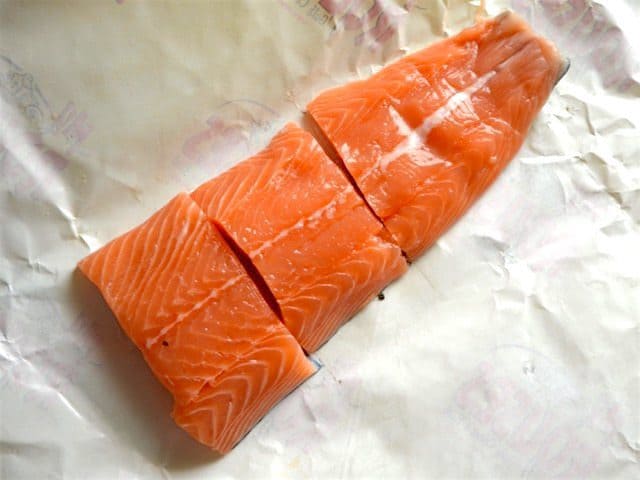
If your salmon still has the skin and scales on it, you have two choices: remove the scales and cook it with the skin on, or remove both the skin and scales. To remove the scales, use a large knife to carefully scrape backward against the scales until they all come off (this can be a bit messy). To remove the skin and scales, carefully slide a sharp knife between the skin and the flesh. Once the skin and/or scales are removed, cut the salmon into three equal-sized pieces (this recipe could easily handle four servings of salmon and beans, if needed).
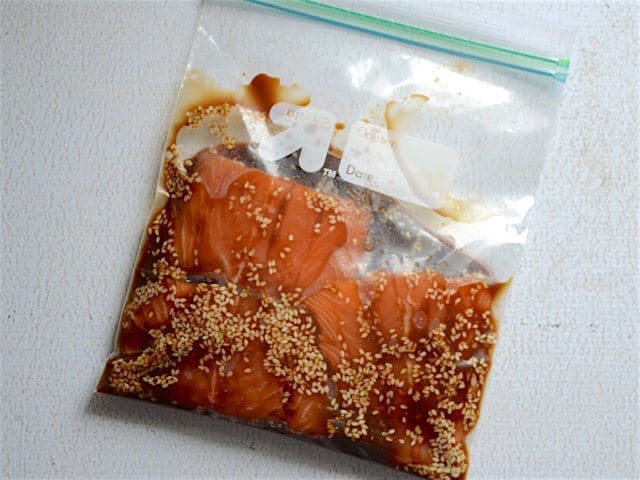
Add the salmon pieces and about half of the marinade to a zip-top bag, and let the fish marinate for about 15 minutes.
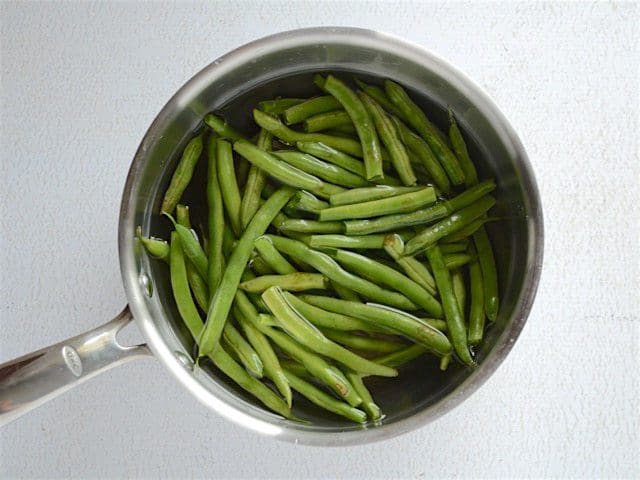
Meanwhile, snap the stems off the green beans and break any long beans in half. Rinse the beans briefly in a colander, then add to a medium sauce pot and cover with water. Place a lid on the pot and bring it up to a boil over high heat. Let the beans boil just until they’re bright green and slightly tender (about 3 minutes).
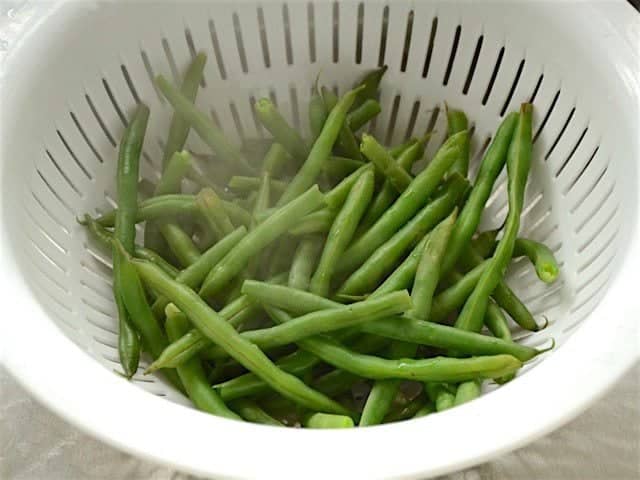
Drain the cooked green beans in a colander.
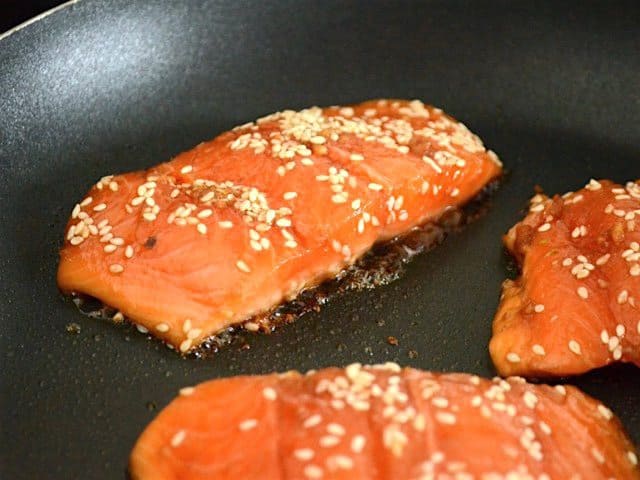
This is one of the few instances where I think it’s best to use a non-stick skillet. Glazes that contain sugar just looooove to stick to metal skillets. I even added a bit of non-stick spray for extra safety. Heat the skillet over medium-low heat. Once hot, add the salmon pieces and cook on each side until the glaze is browned. If you look in the photo you can see how the fish is turning kind of whiteish and opaque near where it’s in contact with the skillet. Watch the fish change color and flip it when that opaque color is about 1/3 the way up the fish. The second side will cook slightly faster, so you’ll want to flip it before the opaque color gets halfway up the filet. Once the whole filet is opaque all the way through, the fish is done.
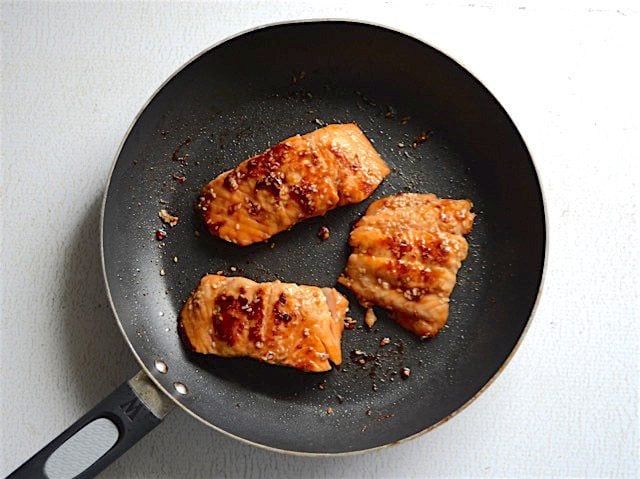
It really only takes about 5 minutes to cook the fish through and get the glaze nice and brown. Of course, this will depend on the heat of your flame and how thin the skillet is. My non-stick skillet is quite a bit thinner than my regular stainless steel set, so I set my flame a tad lower to prevent scorching or cooking the outside of the fish too fast.
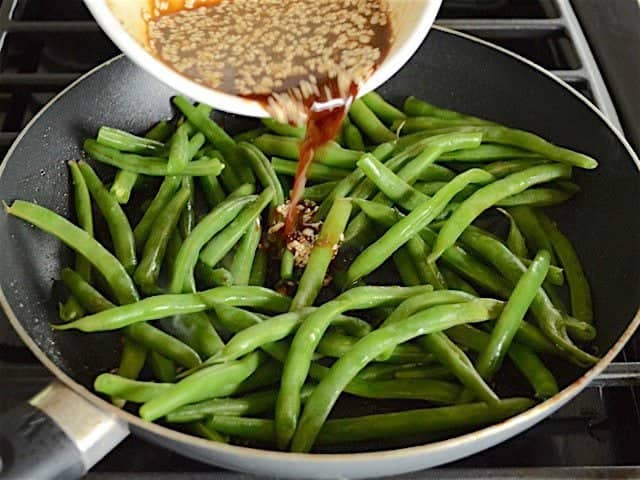
Remove the cooked fish to a clean plate, then add the drained green beans to the skillet. Pour the remaining, unused portion of the marinade over the green beans.
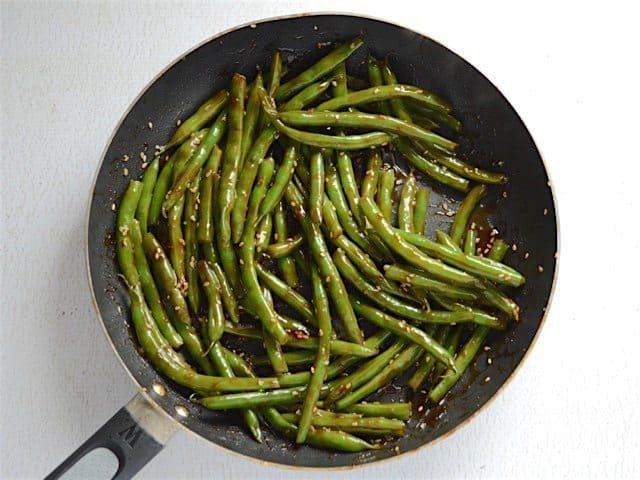
Sauté the green beans in the glaze until the glaze thickens and turns transparent. The beans should be fully coated in the glaze.
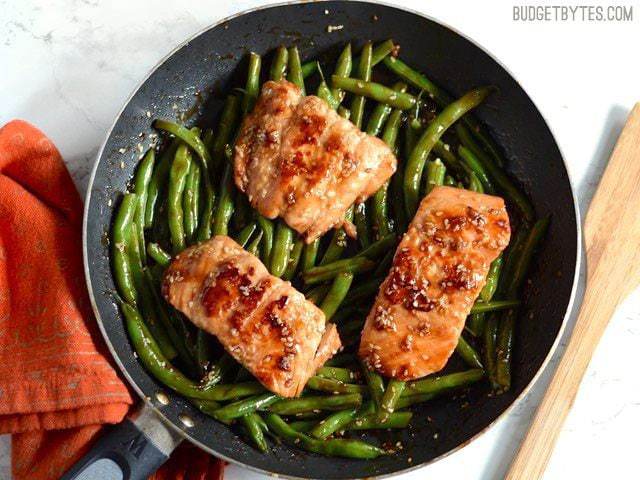
Place the salmon back on top of the green beans and serve.
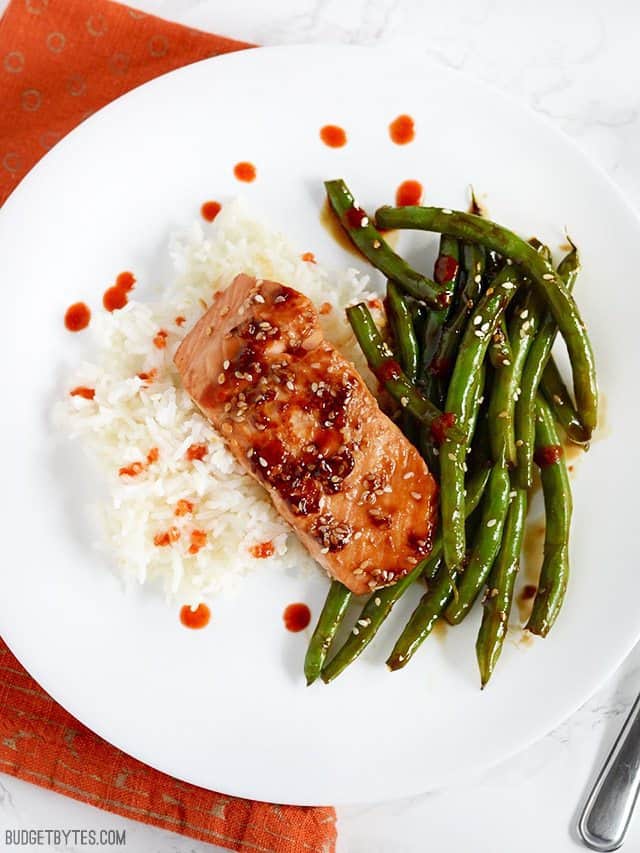
Sesame Glazed Salmon and Green Beans #winning


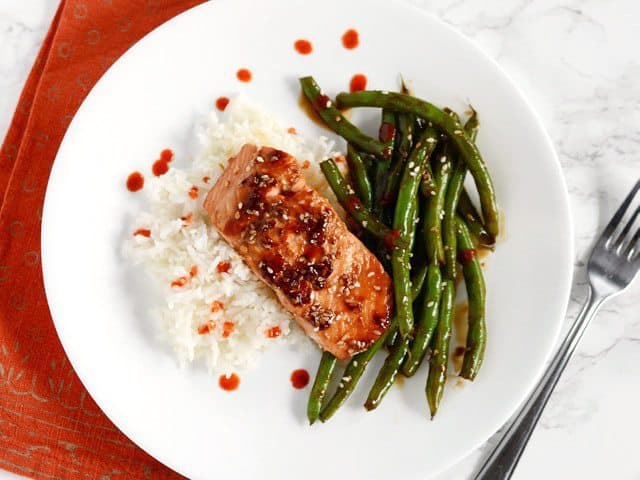
I assume the sesame oil is also supposed to go in the marinade? It’s not listed in steps in the written recipe.
Yep! Thanks for catching that. I’ve fixed it now. :)
I loved the sauce for this! I followed the directions exactly (I almost never do that, haha) and I simply loved the flavors. Thanks so much for another inexpensive and delicious dish.
This recipe was fabulous. Thank you. It will be my go to salmon recipe. Love Asian flavours.
Five Star plus.
This was beyond amazing. Definitely coming back to this dish often.
This was a wonderful – and quick – dish! Even my bf loved it. I just served it with some sauteed spinach, and some other leftovers I had, but next time would definitely go with rice to sop up the sauce.
Currently cooking this recipe – but I made a change in fish. I thought I had salmon when in fact I have flounder! Still I thought it was worth trying. Smells great so far!
Made this tonight for me and the wife. Turned out quite delicious except I was not careful of the heat on the skillet while adding the marinade to the green beans. The marinade almost instantly turned into a thick goop, but was still manageable and tasty! Thanks for this recipe!
I fixed this tonight, with out the ginger (couldn’t figure out where I’d put mine in the kitchen…new mommy brain…), with rice vinegar, and switched the green beans for zucchini because that’s what I have. Also, used frozen salmon (thawed). Super delicious, super easy! Went great with cilantro lime rice that we had leftover. I wanted to rate this 5 stars but when I click on the 5th star only 4 are selected? Anyway, thank you!!
In tropical country like mine, salmon is not considered budget food.. Anyway thanks for the recipe. :)
Seriously inexpensive for a special meal. I bought salmon on Saturday for $6.99 a lb, and grilled it, but this looks wonderful and not much more work. It should even fit into your challenge since by now anyone doing this should have enough “freeze-overs” and pantry item to handle the rest of the week’s meals and a little splurge is good for the soul–particularly when said splurge is as delicious and healthy as this one. Thanks for another great idea.
I like how the pieces of salmon came out in one piece. Every time I cook fish, it flakes apart. Still delicious, but it doesn’t look nearly as nice. I will try using fresh fish in the future.
Hi Beth! What can I replace the mirin with? And do you think canned green beans would work?
I love your website and recipes, by the way:)
I wouldn’t use canned green beans because they’ll be soft, mushy, and not a good color, but frozen green beans might be okay. You can use rice vinegar instead of rice wine, but reduce the amount down to about 1.5 Tbsp.
I used cooking sherry and it was perfect!
Hey Beth, do you think this would work the same with frozen salmon that has been thawed? I found a really good deal on frozen wild-caught salmon a while ago and so I have a ton of that in my freezer. I can never tell if (or how) recipes should be adjusted if you’re using thawed salmon. If you have any thoughts, let me know!
Yes, I think that would work fine. The only issue I’ve had with frozen/thawed salmon is that sometimes it can break down a bit and get mushy, so you’ll just have to be careful with it in the skillet.
Cool, thanks, that makes sense. I’ll try it! :)
We fixed this last night with thawed salmon and it came out beautifully. Such a great recipe that we’ll be repeating next week.
I also used frozen salmon and it worked great. Didn’t fall apart or get mushy.
My husband and I aren’t fish eaters, so do you think this would work with chicken breast? And how would you recommend cooking it?
Yes, I think it would work fine with chicken breast, but you’ll want to pound the breast thin or cut it into small pieces so that it cooks through in the skillet by the time the sauce browns on the outside.
A word of warning: mirin is a heavily-sweetened rice wine. Plain rice wine is called sake, and is usually not available in most supermarkets (even if they sell wine in your state, sake is rarely included).
I found Mirin in my grocery store with the rest of the asian condiments. I was not carded for it, even though I usually am. It clearly says on the bottle that it is 8% alcohol by volume. Interesting.